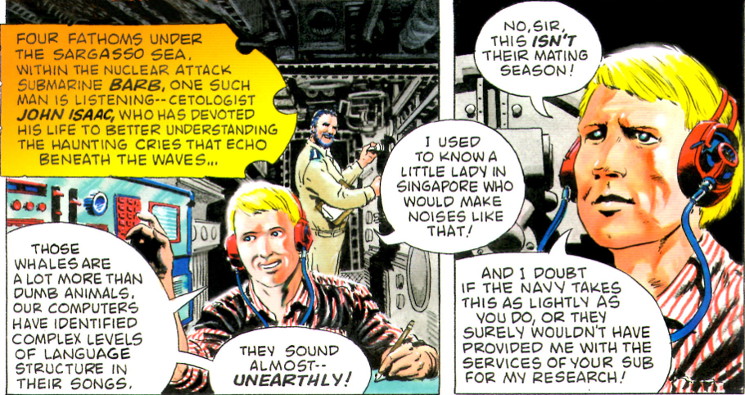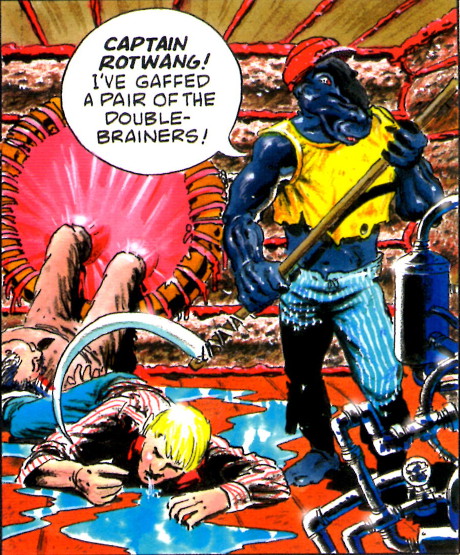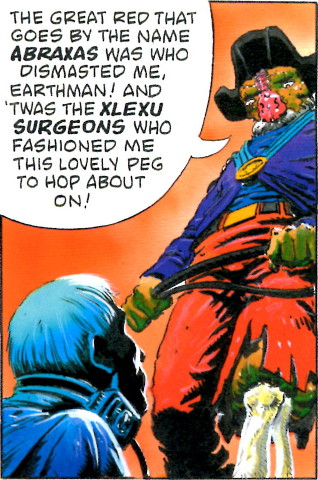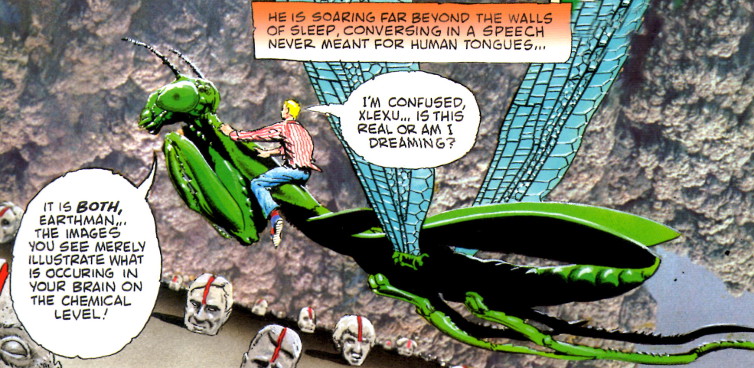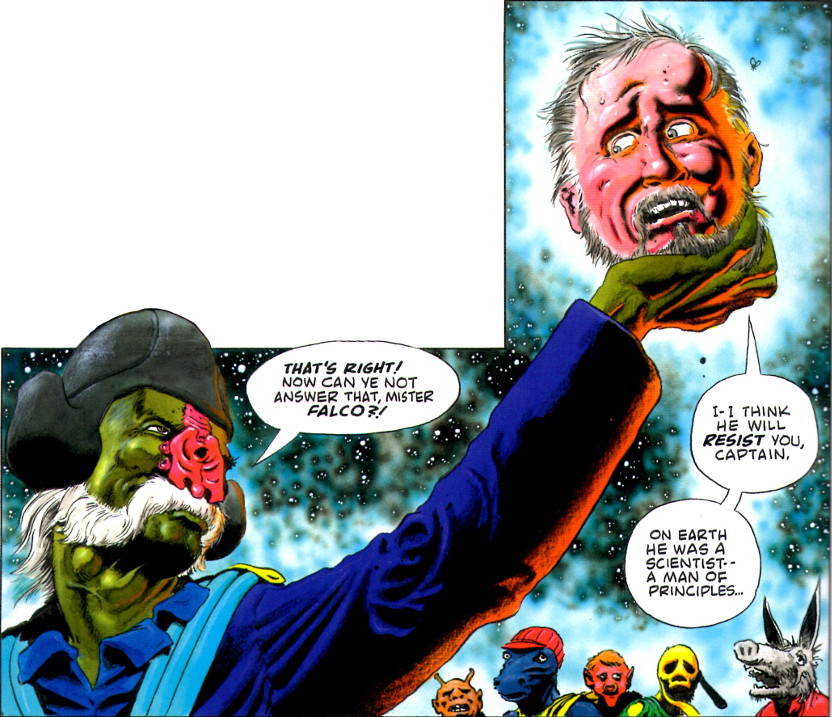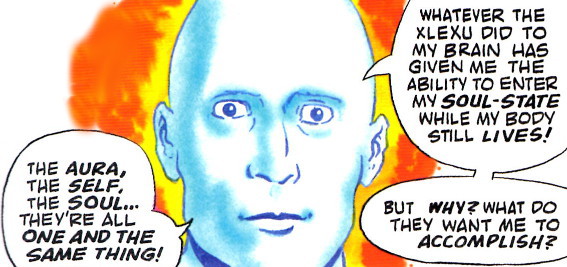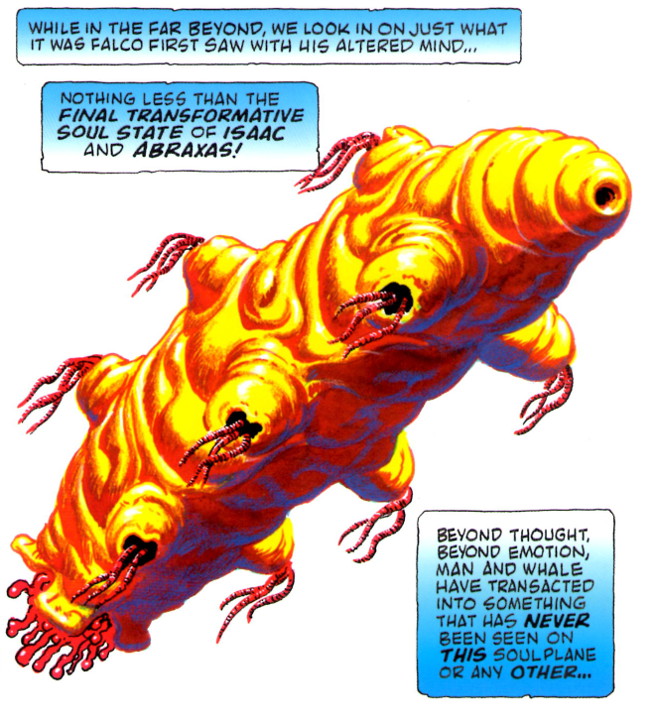Captain Ahab as an alien, space-faring whales, giant praying mantises, and the corpus callosum. What do all these things have in common? They are integral story elements in the lost classic comic story called Abraxas and the Earthman.
Originally published in serial form in Epic Illustrated issues #10-17, the mature magazine offering of Marvel Comics in the 1980s, Abraxas and the Earthman was the brain child of Rick Veitch. Veitch is primary creator and seems to have done the plot, dialog, layout, finished art, and coloring all by himself. The work is best enjoyed in the bound edition published by King Hell Press, even though the page size is slightly smaller than the original.
Veitch’s retelling of Moby Dick seems to have borrowed as much from the hippie culture of the 1970s as it does from the Romanticism period in American history that birthed Melville’s 1851 tale.
The story centers on the bizarre otherworldly adventures of the cetologist John Isaac. Isaac’s psychedelic odyssey starts aboard the nuclear submarine the Barb under the command of Navy Commander Falco.
Their mission is barely underway when they are attacked in true 20,000 Leagues Under the Sea-fashion by a giant squid. This squid, however, is no ordinary denizen of the deep. It sports what looks to be a log cabin on its back, and its large and immensely strong tentacles begin to tear gaping holes in the submarine’s hull. The Barb is soon destroyed and Isaac and Falco face death in the murky waters well below the surface. They are spared this fate when something grabs a hold of Isaac and pulls him to safety while he, wildly clutching at Falco’s leg, rescues his commanding officer.
As soon as they are inside the squid, they discover just how their rescue was effected. A large, purple alien, named Staub, dressed in 18th-century sailor’s garb, had yanked them from the sea and is addressing his captain saying
This is our first glimpse of the strange aliens and bizarre world that inhabit the space whaling fleet, and our first hint that the unusual (perhaps unique) structure of the human brain will play such a major role in the story line.
In answer to Staub’s call, Captain Rotwang walks in on one good leg and one peg
and informs Falco and Isaac that the ‘Great Red Abraxas’ took his leg and that the Xlexu surgeons were ones who fashioned its disgusting replacement.
Rotwang then turns and orders his men to ‘put your backs into it’, leave the Earth and its puny whales behind, and head for the whale planet. The squid/longboat breaks the surface and, hauling two humpback whales in toe, sets out for space. Shortly afterward, they near Rotwang’s giant whaling vessel, named the Yorrikee, which looks more like a self-contained ecosystem than a sailing vessel.
If Melville intended the Pequod to be a microcosm of human existence, I suppose that Veitch intended this star-sailing ship to a be a microcosm of the entire universe.
Once aboard, Rotwang orders the Xlelu surgeons to prepare Isaac for lookout duty and Falco for the furnace. The Xlelu, large aliens that resemble praying mantises, incapacitate each man and then carry them off. Through the strange venom in its bite, the Xlelu merges his consciousness with Isaac. The latter watches in muted fascination as the surgeon removes his skin and then turns his attention inward.
In a dream that isn’t quite a dream but a mental representation of the biochemical changes acting within him,
Isaac witnesses the landscape of his mind. He sees a sea of faces each with a vivid red gash down the center of his forehead. The Xlelu states that these are the faces of John’s former lives, each bearing the mark of the divided double-lobed brain. The Xlelu then merges John’s brain into one harmonious whole.
The Xlelu hang the modified cetologist, now cocooned in a chrysalis, to a branch of one of the trees to await his rebirth.
The physical changes are profound. Where his skin once covered his body, there is now a clear membrane that allows the passerby to see muscle, bone, ligament and tendon as clearly on display as in a medical student’s anatomy book. In addition, Isaac can now see almost the entire electromagnetic spectrum. As radical as these changes are, they are nothing compared to what is in store.
Rotwang shows up on the scene with a devil’s bargain. He offers to restore Isaac if John will help him hunt down the great red whale Abraxas. Convinced that he needs more incentive, Rotwang then shows him the rest of the Xlelu handiwork. A living, body-less Falco is now a plaything, subject to Rotwangs’s whim
while Falco’s body, complete from the neck down, tirelessly tends the Gravity Root, the power source for the Yorrikke.
Reluctantly, John agrees to help, and Rotwang immediately seals the deal by forcing John to participate in the flensing of a whale that has been captured. Flensing involves stripping the outer flesh of the whale from its body, including the skin and the blubber underneath, which is then boiled to get the valuable whale oil contained therein.
Once the whale has been completely butchered, a dispirited John Isaac climbs in some tree branches and falls immediately asleep. Shortly after he begins to slumber, the Yorrikke encounters the whaling vessel Ymir headed by Captain Dolphin. In a meeting closely paralleling the one between the Pequod and the Rachel in Moby Dick, Rotwang sees the horror that Abraxas has visited on the Ymir but, nonetheless, continues in his self-destructive path of vengeance.
The next day, Isaac is forced to take part in the customary post-flensing meal. Rotwang forces him to drink the blood of the slain whale and to take part of its giblet, an organ located in the head of the whale, used to create its song and said to be the seat of its soul.
The giblet acts as a mind-altering drug and Isaac’s aura soon leaves his body to fetch Abraxas.
Finding that Isaac’s job is now done, Rotwang welches on the deal and tries to kill the now insensate human, but he is unable to carry his plan through because at the moment Abraxas arrives, his size dwarfing even the immense extent of the Yorrike.
Seizing the distraction, the Xlelu intervene on John’s behalf and rescue him. They carry his limp body and drop him down the maw of Abraxas.
For the most part, this is the point in which Abraxas and the Earthman begins to depart from Moby Dick. Safely inside the red whale, Isaac, unaware as Abraxas destroys the Yorrikke, begins to piece together what the Xlelu have been up to. He finds a host of Earthmen transformed just like him, all mad from the incessant whale song of pain that Abraxas sings. They force John, who they call self, into the living giblet of Abraxas, where he achieves a kind of soul-communion with the whale. Once inside this mysterious organ, his soul (here defined as the conscious mind joined with his aura)
is liberated and helps to heal Abraxas.
Rotwang is not quite out of the picture though. After acquiring deadly technology from giant aliens (yes it did get weirder), he convinces the rest of the fleet to unite with him to destroy Abraxas. He forces the Xlelu to join the two lobes of Falco’s brain. Falco immediately has a vision where Abraxas is floating and the hunt is back on. Meanwhile, John and Abraxas have now completely merged into a single symbiotic creature – two bodies, two souls, but one entity.
They go on to save numerous souls from the grip of Aion, “the devourer of awareness who strips all memory from souls before sending them back to live another life.” The symbiote then deposits each soul in a whale, thus starting a new race of man-whales.
Rotwang and the fleet close in for the kill but, despite the savageness of their attack with the stolen alien technology, Rotwang’s final grasp at revenge fails to do anything more than injure Abraxas and lead to the destruction of the whaling fleet. The Isaac/Abraxas soul emerges once more, pulls the stinking, blackened soul of Rotwang from his body, and sends it on to be purged by Aion.
As the story closes, the Xlelu, who have tended Abraxas’s wound suffered at the hands of Rotwang, perform a last bit of exposition. They say that as agents of evolution, they have been entrusted with the seed of life (DNA). From that seed they created whales first. Ages ago, the whales engaged in the Great Migration, leaving the whale planet behind and spreading across the universe, giving rise to the various races of men. Now is the time for men and whales to exist in communion.
The Xlelu ask Isaas/Abraxas what they will call their new race. Their answer: “Call me Ishmael.”
And so ends one of the trippiest comics stories I’ve ever read. Part science fiction, part allegory, part moralistic tale, ‘Abraxas and the Earthman’ has some rough spots in both pacing and plot. The end chapters seem rushed as if the serialization were coming to an end and Veitch had to fit some pieces in at the last minute. That said, there is simply no way to view this work as anything other than a classic tale doing what comics do best.
The art and panel layout are vivid, beautiful, and imaginative. The story line is weird in the best sense of that word, exploring concepts that can only be expressed in the medium of sequential art. No amount of descriptive prose can bring home the wonder of the Yorrike, the horror of the bodyless Falco, or the alien nature of the Xlelu. ‘Abraxas and the Earthman’ is a classic tale worth reading and adding to any comic collection.

